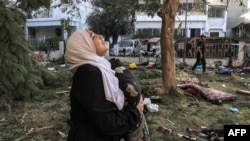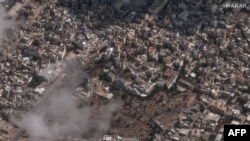The United States is trying to rein in some of the outrage that inflamed tensions and sparked protests around the world following last week's explosion at the Ahli Arab Hospital in Gaza.
Much of the anger has focused on Israel, with many protesters following the lead of the Palestinian militant group Hamas, which accuses Israel of carrying out an airstrike, calling the incident a "genocidal massacre."
But the U.S. has been pushing back, publicly sharing its initial intelligence assessments while also sharing more detailed findings with key governments.
"We have gone out and shared analysis with a lot of our partners around the world," a senior U.S. intelligence official told reporters late Tuesday, speaking on the condition of anonymity because of the sensitive nature of the incident.
"Thus far it's been fairly robust in terms of what we've been able to provide," the official added. "I suspect we will be updating it and sending additional information out as we move forward."
It is unclear, at this point, how much of an impact the intelligence sharing is having.
Jordan and Egypt last week called off a summit with U.S. President Joe Biden in Amman, blaming Israel for the blast. And the explosion continues to be featured prominently at pro-Palestinian demonstrations around the world.
"One of the things that our diplomats have asked … is that the intelligence community do more to lay out our thinking," the senior official said.
And it is not just U.S. diplomats.
"There has been intense interest in the hospital explosion and conflicting accounts about what happened," a second senior U.S. official told VOA. "The U.S. government has worked to be able to share as much information as we could in the interest of transparency."
The tactic of declassifying and sharing this type of sensitive intelligence is increasingly part of the U.S. playbook.
U.S. officials used it most notably in the lead-up to Russia's February 2022 invasion of Ukraine.
Since then, however, the U.S. has used what the White House calls "strategic downgrades" to counter Chinese claims about a spy balloon that traversed much of the United States and to defuse a potential crisis in Mali.
And in the case of last week's explosion at the Ahli Arab Hospital, U.S. intelligence officials believe there is compelling evidence to exonerate Israel.
Based on information culled from a variety of sources, including satellite imagery, data on missile activity and intercepted communications, as well as publicly available video and images, U.S. intelligence officials have concluded with "high confidence" that Israel was not responsible for the hospital explosion.
"There are two primary reasons," said a second U.S. intelligence official, who like the other officials, spoke on the condition of anonymity.
"The first is what we see when we look at the blast effects," the official said. "The damage at the hospital is consistent with what we would expect to see from a rocket and inconsistent with the larger craters and broader blast effects that we would expect to see were this an airdrop munition or an artillery round.
"The detonation of the warhead resulted in only light structural damage at the hospital," the official continued. "There was no observable damage to the main hospital building, no large impact craters, only light damage to the roofs of the two structures near the main hospital building. And both of them remained intact."
The second reason for high confidence that Israel was not involved, according to the official, comes from videos that captured the launch and explosion, from four different angles.
Based on two of the videos, U.S. intelligence determined the rocket was launched from within the Gaza Strip, traveling in a northeasterly direction.
Then, about 10 seconds into the rocket's flight, the motor starts having trouble and becomes unstable.
"We can tell that in part based on the fluctuating intensity of the rocket's plume," the official said.
Five seconds later, the videos show a flash – "our assessment is that that is the rocket motor failing," the official said, and five seconds after that, one object hit the ground followed by a second, a few seconds later, resulting in a large explosion.
"Our conclusion is that there was a catastrophic motor failure that likely occurred which separated the motor and the warhead," the official said. "The warhead landed in the hospital compound."
Gaza's health ministry said the explosion killed about 500 people. But U.S. officials told VOA news last week that they assessed the number of deaths was likely between 100 and 300, with the actual death toll likely on the lower end of the scale.
Officials late Tuesday said getting a more accurate count will likely be difficult and cast doubt on the ability of Hamas authorities to keep track of casualties given that they themselves "are struggling to function at this point in time."
U.S. intelligence officials likewise pushed back on some theories, popular on social media, that seek to blame Israel for a Palestinian rocket falling in Gaza, including claims that the rocket was shot down by Israel's Iron Dome defense system.
"Our understanding is that the Iron Dome would not intercept a rocket that was still burning," the U.S. intelligence official said. "Their SOPs [standard operating procedures] are that they would have to calculate where it's likely to go. And until that rocket has finished burning through its propellant, it's not going to be clear exactly how far it's going to go."
And the officials backed up Israeli claims that the failure rate for Hamas rockets is high. Israel in recent days has said that on Oct. 21 alone, as many as one in five Hamas rockets failed, hitting Gaza instead of targets in Israel.
One area in which U.S. intelligence is still trying to get clarity is the question of who fired the rocket that ended up striking the Ahli Arab Hospital.
The current U.S. assessment points to Palestinian Islamic Jihad, another Palestinian militant group, as the most likely culprit. But officials say they have "low confidence" in the finding because it is based, in part, on an intercepted communication between other militants thought to be part of Hamas.
"They themselves are speculating about who's responsible," the U.S. intelligence official said, adding the audio examined by U.S. intelligence is different than audio circulated by Israeli officials last week, which has been subject to criticism.
"There is additional audio that was passed to us by the Israelis that has been carefully vetted and determined to be authentic communications of Palestinian militants. … The language patterns have been evaluated and determined to be authentic," according to the official.
Palestinian Islamic Jihad has denied it launched the rocket that fell on the Ahli Arab Hospital.
But U.S. officials counter that, using geolocation techniques and other data, they are confident the rocket that caused the damage was fired from Gaza and suffered a catastrophic failure, causing the warhead to land by the hospital.
Still, they say if new information comes to light, they will examine it closely.
"This issue is not closed for us," said the senior U.S. intelligence official. "If we get additional information that would point in a different direction, we would report that out, as well."









